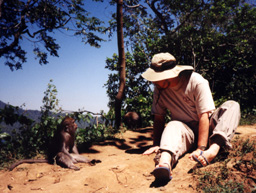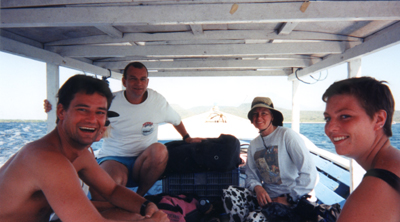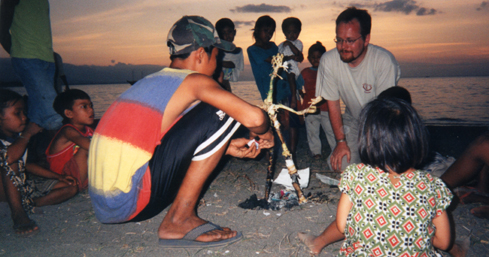Bali Trip, 1998
GEOGRAPHY, FLORA, FAUNA
Bali is a small island (roughly 90 miles east-west by 50 miles north-south)
in the Indonesian archipelago, about eight degrees south of the equator.
Its inhabitants are ethnic Malays - a widespread Polynesian race.

I was surprised at how few birds I saw in the air in Bali. In New Zealand,
they were all over the place, especially the keas. There also weren't as many
insects as I would have imagined for such a lush environment; maybe that's
why there weren't many birds. There are a few monkeys, and deer also exist
on the island.
There were a lot of dogs and chickens roaming about. They had owners,
but were let out to wander around. I was surprised at how quiet (in
general) they were and how well-behaved (in general) they were.
The Balinese
will eat dog. (One time when the driver rushed a dog in the street,
my dive instructor (a Liverpudlian) grinned and yelled, "Satay!") So I guess
what I saw was basically free-range hound.
There are a few mountains in the sparsely populated north, but the south
was pretty flat. It was pretty lush except for the extreme north, where
it looked sort of scruffy like southern California. There were lots of palm
trees and lots of rice paddies. (Someone asked me if it was beautiful, but
I think that depends on what you like. I see rice paddies and think
"farm", not "beauty" or "quaint".)
DIVING

It should also be noted that I spent most of my time in Bali looking at
things under the water. I (finally!) got my Open Water scuba certification
in Bali, then Jim and I took the Advanced Open Water class together.
(I did ten dives in three days. Oof! I got an ear infection, too.)
The reefs in Bali are pretty spectacular. Fishies everywhere! We also did
three wreck dives at Tulamben for our Advanced Open Water class (covering
our Deep Dive, Wreck Dive, and Night Dive). Tulamben has a sunken Liberty
ship that is between 5m and 30m below the surface. The hull has grown lots
of coral, which supports lots of fish. Much fun. No, we did not go inside -
that's very dangerous. Divers' bubbles tend to knock grunge down off the
ceiling and make visibility nil. Nil visibility makes it hard to get out
of the ship before your air runs out.
 At Tulamben, we also saw a spectacular sunrise.
At Tulamben, we also saw a spectacular sunrise.
TRANSPORTATION
Getting around the island was really easy. There were two bus companies
that had regular schedules and went everywhere we wanted to go. The buses
usually were not air-conditioned, but the breeze from the windows helped.
For local transportation, there are "bemos", equivalent to the jitneys
that used to run in America. They are sort of a cross between a taxi and
a bus: no set schedule, but they run pretty much continuously down the
main drag, cruising for passengers. They were about ten cents apiece.
It is also dirt-easy to hire a car and driver for an hour, day, whatever.
There are drivers EVERYWHERE looking for work.
There were also taxis at the airport, but I didn't see too many elsewhere.
Of course, I wouldn't see too many underwater.
There are three times as many motorbikes as cars. They are generally
light bikes - there are way more scooters than "crotch rockets".
I had heard that everyone drove like a maniac there. I disagree. They
have just have a different protocol. Their protocol is dangerous for
people using US protocols, but is safe enough if you are aware of their rules.
They are:
- Don't accelerate or decelerate very quickly.
- Don't drive very fast. (35 mph seemed pretty standard.)
- Don't be agressive.
- Honk your horn lightly to let people know where you are. Do not use
your horn to indicate anger. (In fact, don't be angry. Chill out.)
- If the oncoming traffic is far enough away, it is perfectly
reasonable to use the oncoming lane to pass others. Even in cities.
- If the oncoming traffic is a ways away and you need to turn across
the oncoming lane, get into the oncoming lane as soon as you practically
can. Do NOT drive right up to the turn, then stop dead while oncoming
traffic (which has caught up while you were slowing down) clears out.
- When the difference in speed between you and everyone else is low
(which should always be the case), it is appropriate to squeeze past them.
This is true even if you only have four inches of clearance. A miss is
as good as a mile.
Note: I never saw any accidents, but Jim saw three separate instances of
someone lying unconscious next to the road. I suspect that riding a
motorcycle is much more dangerous than riding a car. I also suspect that
tourists are much more dangerous to the locals than the locals are.
LANGUAGE
While there is a local Balinese language, Indonesia's official language is
Bahasa Indonesia that everyone speaks. Bahasa Indonesia (translating
literally as "Indonesian Language") is essentially identical to Bahasa
Malaysia, and I will call them both "Malay". Malay has a very regular
grammar and regular spelling, and it is very easy to learn some of the
basics. For example, there are no plural forms. To emphasize that something
is plural, you double the word: "kucing" is cat or cats, "kucing-kucing" is
cats. There is no verb conjugation as we think of it; 'makan' can be used to
translate the English eats, eat, is eating, are eating, has eaten, had eaten,
will eat, and so on. The time frame is determined either by explicit
reference ("Last Tuesday...") or by little helper words (just, already,
almost, about to).
The tricky part of the language comes from different status levels, much
like Japanese. There are lots of different words for "you" depending
upon the relative status levels of the speaker and the listener.
Malay also puts the most important thing of the sentance first.
Where we would say, "You may eat the fruit", they would consider
"the fruit" to be the most important part of the sentance, and say, "The fruit
may be eaten by you." The extensive use of passive voice also lets
speakers avoid decisions about what form of "you" to use: "The fruit
may be eaten". I've also heard that the English word "you" is starting to be
used in Malay to allow people a status-free second person form.
RELIGION
While most of Indonesia is Muslim, Islam never got a strong hold on Bali.
Bali was converted to Hindu back a little later than 1000 AD, but retained
a very strong, distinctively local flavor.
One feature of their religion is that doing bad things not only gives the
transgressor bad karma, it also gives bad karma to all the transgressor's
descendants! The people are thus extremely honest. We left a backpack
at a rest stop, and when we discovered that an hour later
and 50 km away, the bus people said, "oh, no problem, we'll just pick it
up tomorrow and bring it down." We asked if we could call to check that
it had been found. They thought it was a bit odd that we'd need to do that,
but called up. Yes, it was there, yes, they'd send it down. The next
day, it showed up right when they said it would, intact and apparently
unopened. Even the $100 in rupiah (which is a LOT of money in Bali right
now) was untouched. (Note: other tourists are not so honest, so one
should still watch one's valuables.)
Balinese religion is extremely rich in ritual. Every day, we would see
people (usually women) putting out offerings. A common offering was a
leaf holding a rice-based treat, a flower and some burning incense. These
would be put at shrines or even just on the sidewalks. There are temples
all over the place, and every home has at least one shrine/temple in it.
It was not strange to see processions of one sort or another going down the
street, with all the people dressed in their temple clothes.

We have a story that illustrates how richly ritualistic Bali is. Jim has
gone to Burning Man for several years, and was a little bummed at missing
it this year. (What is Burning Man? Well, it's a little difficult to
describe to Americans. It's a big festival where they burn a big wooden
sculpture of a man.) One evening, he said, "Hey! It's Burning Man Suday! I'm
going to go build a man on the beach and burn it." He attracted quite a
crowd of local kids and a few adults. While you probably scratched your
head and asked, "Why do they burn a man? What's the point?", the Balinese
just said, "Oh, got it. We'll help!". So this band of about 15 kids and
a few adults helped Jim create a man (anatomically correct even!) made of
palm fronds, and burn it.
TOLERANCE
Their culture/religion is also very tolerant.
Example one: We went to a cremation ceremony. I felt a bit uncomfortable
there, intruding on a private moment. But I talked to a Balinese man there,
and he said, "Oh no, it's perfectly natural that tourists would be
interested. We don't have a problem with it; we have to focus on what we need
to do, namely finish the cremation."
I asked him if it was ok for me to not be in temple clothes. "Oh yeah, we
understand you're tourists and don't know any better. It would be better
if you were in temple clothes, that would show us that you understand and
respect our traditions, but it's ok to not wear them." (I actually thought
that the tourists who did wear the temple clothes - sarong and prayer belt -
over their clothes looks out of place. Imagine a group of foreign businessmen
in dark suits who go to a baseball game and are told: "You need to wear
T-shirts" and put the T-shirts on over their suits. That's what it felt like
to me.)
ECONOMY
Example two of tolerance: The economy in Indonesia overall was in really
bad shape in 1998. The rupiah fell from about 2300/US$ to about 11000/US$ in
about two years. The price of rice went from 700 rupiah/kg to
5000/kg in the past eight months. People were hurting. In many places in
Indonesia, the majority Malays have taken it out on the ethnic Chinese
minority, who control most of the wealth. Shops were burned, Chinese
people, have been killed, and there may or may not have been systematic rapes.
EXCEPT in Bali. When we looked into going to Bali, we found the State
Department was advising against going anywhere in Indonesia except Bali.
"There have been no disturbances in Bali."
A side note on the ethnic Chinese: Malay culture is relationship-based, not
rule-based. (This is not uncommon in Asia, and is one of the "Asian Values"
that Malaysia's prime minister liked to go on about before their economy
tanked.) My Indonesian culture book says that family is extremely important
to Malays; so much so that if a family member asks another for something,
the latter pretty much has to give it to the former. That makes it very
difficult for individuals to accumulate wealth. Families can get richer
than other families, but individuals can't get much wealthier than their
poorest relatives. The ethnic Chinese don't have such strong obligations,
so it is much easier for them to hold onto capital and start businesses.
Hence the Chinese-Indonesians control most of the wealth. (Caveat: I'm
not an expert on the territory, that's just my interpretation and conclusion.)
Tourism was way down. My dive instructor said it was about 15% of normal.
There are several possible contributions:
1) With the Asian economy in the toilet, Asians don't have as much money
to travel. (We did see a fair number of Japanese tourists, however.)
2) People may be worried about potential civil unrest. We were, before
we asked the Web if Bali had been affected. (The whole time we were travelling,
we spoke with only five Americans - who were living in Vietnam, Vienna,
Indonesia, Cleveland, and unknown.)
3) I hear that Chinese-Indonesians are pouring into Bali as a haven from
violence. They are buying houses, not going to tourist attractions.
They are also hanging out in southern Bali (maybe because it is
closer to the airport?), while the dive shop was in the north. (In Malaysia,
we met some Australians who had wanted to go to Bali but hadn't been able
to get a flight in.)
I was surprised to see a fair number of women working in construction-type
jobs. I even saw a woman carry a bag of concrete on her head! It would
appear that the stereotype of women being frail creatures and unsuited for
hard labor is a luxury that Bali can't afford.
TOUTS
Because of the poor state of the economy and the relative wealth of tourists,
tourists got hit up a lot. Especially in the more touristy areas, you
couldn't walk two blocks without hearing a constand and hopeful, "Transport?
Transport?" This was annoying but it should be said that they usually took
no for an answer, especially if you said it in Malay. Also, it was very
handy at times. If we wanted any sort of errand run - buy stamps, buy
toilet paper, guide us to such-and-such a sight - it was no problem to
get someone to do that for us. Example: we were out late at an Internet
cafe, and weren't sure if the bemos (jitneys) were still running. One
question asked resulted in two other guys driving us back to our hotel on
their motorbikes for something like 30 cents.
ARCHITECTURE

The relationship between "inside" and "outside" is a lot fuzzier in Bali
than in the US. Here a home is really a box, with stuff inside. There,
homes are walled compounds with several structures. Each structure will
have a pointy thatched roof covering a large veranda and usually an
enclosed room. (The above picture is on the porch of our first hotel.)
So the TV room might be on a veranda. The guest bedroom
is probably in a different building. I did see some boxy homes in some
regions, but that was the exception and not the rule.
Pretty much all floors are tile, and shoes are removed before going on the
tile. (This is as true for shops as for homes.) This was annoying for me
because my broken foot really prefered to have cushioning. Sometimes I
would just decide that I was a stupid tourist and didn't know any better.

Almost all private homes, temples, government buildings, restaurants, and
even some of the shops were very ornately decorated. Even the airport had
a highly decorated ceremonial gate.
One interesting feature of the architecture that I quite liked was the open-air
bathrooms. There would be a piece of the ceiling missing in most bathrooms.
Frequently, there would be a tiny courtyard just beyond the bathroom, with
plants and perhaps grass. This would give great ventilation without
sacrificing privacy. Alas, I think this wouldn't work in the frost belt.


 At Tulamben, we also saw a spectacular sunrise.
At Tulamben, we also saw a spectacular sunrise.


